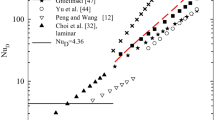Abstract
We measured the macroscopic boundary angles of wetting by water, acetone, and pentane of the capillary structures of antigravity heat pipes in the 293–363 °K temperature range.
Similar content being viewed by others
Literature cited
M. G. Semena, B. I. Rybkin, E. M. Sidorenko, et al., “Investigation of boundary angles of wetting of the wicks of low-temperature heat pipes,” Inzh.-Fiz. Zh.,28, No. 2, 217–221 (1975).
B. I. Rybkin, M. G. Semena, E. M. Sidorenko, et al., “Investigation of boundary angles of wetting of capillary structures by low-temperature coolants,” Prom. Teplotekh.,5, 42–47 (1983).
B. I. Rybkin, Yu. Yu. Sergeev, M. G. Semena, et al., “Investigation of the boundary angle of wetting of the mesh wicks of heat pipes by coolants,” Inzh.-Fiz. Zh.,36, No. 4, 620–626 (1979).
A. D. Zimon, Adhesion of Liquids and Wetting [Russian translation], Khimiya, Moscow (1974).
V. I. Nizhenko, B. B. Bogatyrenko, A. G. Kostornov, et al., “Investigation of equilibrium boundary angles of the wetting by water, ethanol, and acetone of structural materials by low-temperature heat pipes,” in: Thermophysical Research [in Russian], Vol. 2, Fizika Energeticheskii Inst., Obninsk (1980), pp. 90–97.
B. V. Deryagin, “Variation of the boundary angle as a function of the microrelief or the roughness of the wetted surface,” Dokl. Akad. Nauk SSSR,51, No. 5, 357–360 (1946).
L. M. Shcherbakov, “General theory of capillary effects of the second kind,” in: Research in the Field of Surface Forces [in Russian], Izd. Akad. Nauk SSSR, Moscow (1961), pp. 28–37.
B. D. Summ and Yu. V. Goryunov, Physicochemical Foundations of Wetting and the Spreading of Liquids [in Russian], Khimiya, Moscow (1976), pp. 71–76.
G. V. Kuskov and Yu. F. Maidanik, “On the question of the boundary angles of wetting of the capillary structures of heat pipes,” Submitted to the VINITI on June 8, 1983, No. 3781-83 Dep.
Yu. F. Gerasimov, G. T. Shchegolev, Yu. F. Maidanik, et al., “A low-temperature heat pipe with different channels for vapor and liquid,” Teplofiz. Vys. Temp.,12, No. 5, 1131–1134 (1974).
Yu. F. Gerasimov, Yu. F. Maidanik, G. T. Shchegolev, et al., “Low-temperature heat pipe with different channels for vapor and liquid,” Inzh.-Fiz. Zh.,28, No. 6, 957–960 (1975).
Yu. F. Maidanik and G. V. Kuskov, “Porous titanium materials for capillary structures of heat pipes,” Poroshk. Metall., No. 1, 36–38 (1983).
Author information
Authors and Affiliations
Additional information
Translated from Inzhenerno-Fizicheskii Zhurnal, Vol. 50, No. 1, pp. 66–71, January, 1986.
Rights and permissions
About this article
Cite this article
Kuskov, G.V., Maidanik, Y.F. Macroscopic boundary angles of wetting of sintered capillary structures of heat pipes. Journal of Engineering Physics 50, 53–58 (1986). https://doi.org/10.1007/BF00871411
Received:
Issue Date:
DOI: https://doi.org/10.1007/BF00871411




